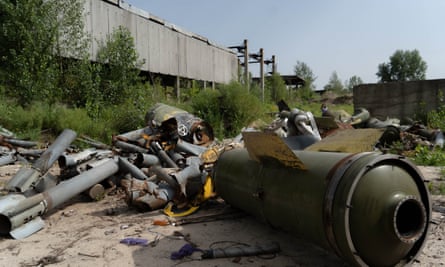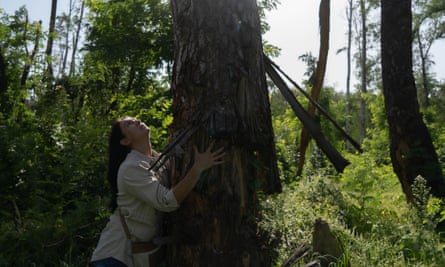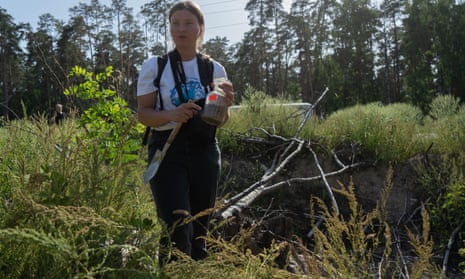The woods outside Chernihiv were quiet in late August when Anatoliy Pavelko scrambled into a 10-metre bomb crater with a trowel and an icebox full of sample jars. He wanted to find out what the Russian FAB-250 bomb left behind when it carved this gaping hole into the ground in the spring.
Four months earlier, the environmental lawyer was dug in on a frontline just a few kilometres away, shells crashing around him in the bitter fight to keep Russian forces out of Kyiv.
Now he has taken temporary leave from his unit of volunteers and returned to Chernihiv for a more familiar battle on a different front in the war against Moscow.
Russia’s invasion has killed tens of thousands of Ukrainians and destroyed homes and entire cities. It is also devastating Ukraine’s environment, an “ecocide” that activists worry is going largely unrecorded amid the broader national tragedy.
“Most people pay attention to loss of life and damage to infrastructure, but lots of people and even the national government forget about losses and damage caused to the environment,” said Pavelko, who specialised in protection of rivers before the war.

Now he and other activists have launched an urgent campaign to catalogue the damage and future risks, from toxins left by shells in agricultural soil to chemicals leached into groundwater after bombings and fires, and from ancient woodland torn apart by modern weapons to rivers tainted by sewage after waste treatment sites were bombed.
They hope to use their investigations to bring an international lawsuit and force Moscow to pay clean-up costs and compensation.
“If we expect Russians to pay for the damage caused, we should pay special attention to the facts of the crime, and this is a situation where they aren’t properly documented.”
The environmental risks of Moscow’s war have been brought into sharp focus by a string of crises at the Zaporizhzhia nuclear plant, Europe’s largest. It was seized by Russian forces in March and used as a military staging post, with Ukrainian and international officials warning that reckless behaviour by occupying troops has sharply raised the risk of a nuclear accident.
But environmentalists want to highlight the damage that has already taken place. They have chosen Chernihiv for a case study in part because the Russians have left, so research is not dangerous, but also because of the intensity of the fighting here.
Its streets, fields and forests provide a grim catalogue of the many types of environmental damage inflicted by Russian troops and of the contamination caused by different weapons systems.
The city is within a few dozen kilometres of the border with Belarus, where Russian troops massed for the invasion and from where they launched missiles. It endured a 41-day siege with attacks that tainted water, air and soil, destroyed natural resources and damaged a key water treatment plant. Some of the effects lasted only hours, while others will be felt for years and yet more could linger permanently without clean-up efforts.
At the Epicentr K building supplies superstore that was badly hit then went up in flames, the acrid smell of burnt plastic still lingers months later. Chemicals released in smoke will have settled across the city and other toxins have probably leached into groundwater from the burnt ruins after months of rain.
The environmentalists captured photos of the damage, which will be cross-referenced with company documents to try to calculate how many tonnes of plastics and other materials went up in flames and what chemicals they released.
There is medium-term environmental damage at a key water treatment plant in the city, damaged in repeated shelling, so it no longer has capacity to treat all the sewage piped in after heavy rains.
Managers fear in the autumn they will have to release untreated waste into a nearby river that flows down to the capital. “If the water isn’t cleaned, people in Kyiv will have shit in their drinking water,” plant manager Natalia Mazyuk said bluntly. The facility had been newly upgraded; one of the tanks that was put out of service had only gone into operation a month before it was bombed.
A city oil depot, set ablaze in a bombing, burned for days, causing breathing problems and releasing chemicals that will have settled on the ground and sunk into water supplies.
There are trees and whole areas of woodland destroyed by shelling and bombs that will take decades to grow back. Their ecosystems will also need years to recover, robbing the people of Chernihiv of an important resource.
“Environmentalists insist that the beauty of nature also has value. People have lost places for recreation, where they spent time with their families and they can’t just be rebuilt like, for example, a supermarket,” said Hanna Hopko, a Ukrainian activist and politician who is part of the campaign for environmental accountability.
“We need generations to see 150- year-old oak trees grow back from first planting,” she said. “Even my daughter will never see this destroyed nature [fully restored], probably only her grandkids.”
And finally there are the shell craters in the forest that contain clues to the deadly long-term legacy of even those munitions that did not kill or injure anyone. “There are toxic materials in a crater after the explosion,” said Kateryna Polyanska, an analyst with the activist group Environment People Law. “A lot are landing in agricultural fields and these can migrate through the food chain through agricultural production. Also, these elements can leach through the ground soil to our rivers, then go to our bodies.”

In Chernihiv, Russia’s military used almost every weapon in its arsenal, from long-range missiles to short-range shells. Their twisted remains are stored at an old industrial site on the city’s outskirts, along with the almost unrecognisable fragments of a fighter jet shot down in the area.
It is the kind of open-air memorial to the terrible destructive power of modern technology that environmentalists hope could also underpin calculations of damage nationwide, including areas still too heavily contested for them to visit.
Pavelko and Polyanska collect soil from bomb craters to be analysed for contamination, along with samples from untouched ground nearby to provide a control measurement.
The difference will help estimate what came from bombs and what might be historical local pollution from heavy industry or past disasters, including the 1986 nuclear disaster at Chernobyl, which is only about 50 miles west.
If they can calculate the pollution caused by a particular type of munitions in Chernihiv, they can also use that to calculate damage in areas that are harder to reach.
“We need to know more about different types of missiles, bombs, etc. When you know typical pollution that craters contain, you can estimate what might be in other craters,” said Polyanska. “Sometimes we have no access to these places because there is still a war and it is very dangerous, but we can assess these things with satellite images.”
While they collect evidence in Chernihiv, they have been running a media campaign to raise awareness nationwide of environmental crimes.
“Nature is a part of what’s helping us to recover. And this is why environmental crimes are a part of a Russian full-scale war, genocidal war,” Hopko said. “It’s also why we have to demand compensations, for this beauty, which our next generations in some part of Ukraine will not see. Instead, we have to find money just to clean our water, clean our land and air from toxic hazardous elements.”
Ukrainians have been racing to rebuild areas that were occupied or saw heavy fighting as they search to restore some kind of normality to daily life. The clean-up is inspiring, but it is also worrying for lawyers who need evidence. “When we were here in spring, it looked really horrible. But in three months, lots of things were repaired,” Pavelko said.
“A part of serious damage, not only environmental but also economic damage, was not properly documented. Ukrainians try to repair everything as soon as possible. But you have to document everything if you are going to get compensation.”
